Introducing Fritz 17 with Fat Fritz and other goodies
In our most ambitious release yet, Fritz 17 brings a slew of features such as new functions to help you build your repertoire, special tools to help memorize it, new ways to generate exercises from your games, and more! It also brings not one, but several new engines such as the latest Fat Fritz with new percentage displays, the new Fritz 17 engine, and an easy-to-install Leela for the fans of the open-source project, and more! We have published a few articles on Fat Fritz before, in this one we are going to tell you all new features of Fritz 17 and what is the primary hardware requirement for Fat Fritz to get optimum performance.
What's new in Fritz 17
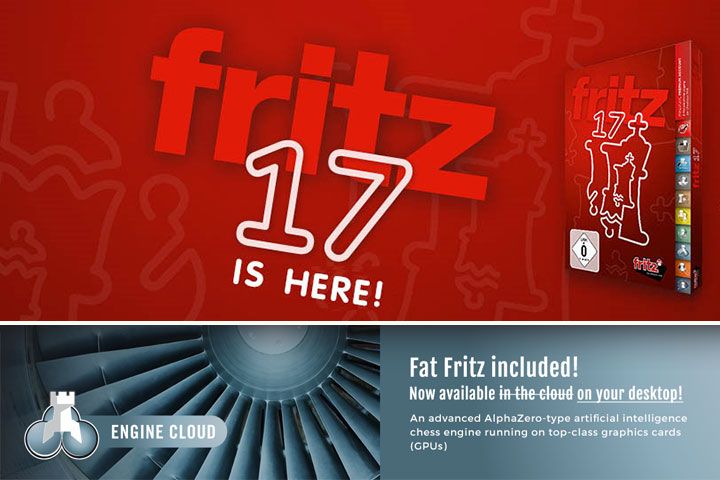
How do you improve and build upon the world’s longest lasting chess playing program series? If you have followed the news pages for the last few months, you will have heard of Fat Fritz as a concept, and while it is indeed the show-stopping addition to Fritz 17, it is far from the only novelty. For one thing, a brand new Fritz 17 engine is now in place with no need for a fancy graphics card to reap the benefits. Developed by Frank Schneider, the author of a very strong private engine known as Gingko, the new Fritz 17 engine will not only surpass the previous Fritz 16, but also provide new analysis for those seeking yet another new look at things.
As far as the interface is concerned, the key concept is 'helping you learn'. A number of brand new functions have been created with the sole purpose of helping you learn and train your openings. Let's face it, while studying openings can be fun, memorizing them is not and is often the reason many players avoid openings they might prefer, because of the challenge that presents. Fritz 17 brings an assortment of tools to help you and make that process as painless as possible.

Finally, Fritz 17 and ChessBase will not be left behind in the wave of new 3D technology. Readers may have heard about the concept of Ray Tracing, the new buzzword by Nvidia on fantastic lighting in 3D models, even used to debunk moon landing conspiracy theories by demonstrating the accuracy of all lighting effects. Their new series of video cards was designed around this concept, and new games and 3D modeling have exploded with the steady inclusion of it. New in Fritz 17 is a powerful set of live ray tracing effects for the 3D chess boards, with a staggering amount of control on how and where they are lit. Even fancy camera effects such as background blurring are possible. However, these do require those fancy new video cards to be enabled.
In any previous version of Fritz, all the above would more than justify a new version and release, but the icing on the cake is of course Fat Fritz.
Fat Fritz
The pièce de résistance in Fritz 17 for many people will be the inclusion of Fat Fritz. Based on the AI technology by DeepMind that created AlphaZero, Fat Fritz is a new set of custom made neural network weights that work in the open-source project Leela Chess Zero. The Leela Chess Zero project is based on the Go program Leela Zero and was designed to reproduce AlphaZero on the PC. One of the key tenets is that it follows the ‘zero’ philosophy which means it uses nothing except what it learns of its own accord.
The philosophy behind Fat Fritz has been to make it the strongest and most versatile neural network by including material from all sources with no such 'zero' restrictions, such as millions of the best games in history played by humans, games by the best engines including Stockfish, Rybka, Houdini, and more, endgame tablebases, openings, and so on. If it was deemed a possible source of improvement, ‘zero’ or not, it was used. Even millions of exclusive self-play games were created, but tweaked to create content that was more aggressive and speculative to learn from and mold its style. The only material that was not used to train Fat Fritz, out of principle, was content from the Leela project itself, as this was developed by their community for their neural networks.
After over a year of development, thousands of hours of computer time and human effort, we feel this will enrich analysts and players with creative and unique moves, all of the highest quality, to explore openings and the middlegame. While there is no question that making sure the engine can bring the highest standard is vital, and worry not it is there, it would be quite uninteresting to present an analyst that was essentially exactly the same as Engine X, except 20 Elo better. Instead, a contrasting point of view, no less strong, is far more interesting, and of far greater use.
Over the past weeks, many games, matches, and articles we have waxed poetic on its virtues, but instead of just throwing more mind-numbing results — however good — the following game speaks far louder than words on what sort of player it is.
This was a draw (yes, a draw, but what a draw!) between Leela and Fat Fritz in a game played without a book by Fat Fritz. It played the French defense, and took a line that is considered by theory to be quite bad for Black, and saved it with novel moves, and then gave up pawn after pawn to fight with dynamic play.
Important note: While Fat Fritz is already incredibly strong, its development is not over, and over the next months, owners of Fritz 17 will enjoy upgrades to the neural network.
Leela
Many fans of Leela have complained about the complications in the installation process and requested a solution by ChessBase. As such Leela will also come installed with its best neural network (and you can always use another of course) and configured for use on the spot. Hopefully this will help bring more users and admirers to their project as a result.
The Graphics Card question
Readers will have seen that to use Fat Fritz and Leela properly you will need a solid graphics card. There really is no way to get around this. The neural network weights are a massive file with tens of millions of values that comprise its vast knowledge of the game, and while the calculations are all done on the CPU, the graphics card, thanks to its unique design, is used to read the neural network and feed the CPU the evaluation for every position it examines. Even though Fat Fritz might be running a thousand times slower than conventional engines, it will still provide top analysis, but without a graphics card the experience will be only useful as a demonstration, and will be slower by a factor of 1000-2000.

The recommended hardware is an Nvidia RTX 2060 or faster, but the better the card, the better the experience. Needless to say, a graphics card will also bring far more advantages than just running Fat Fritz, such as gaming, 3D graphics, video rendering, AI development, and more. On the upside, nearly any computer can use this and there is no need to buy an entirely new machine. The Fat Fritz in the Engine Cloud runs on a quite modest quad-core CPU (five years old), though bolstered by two fast RTX 2080 video cards.
True percentile output
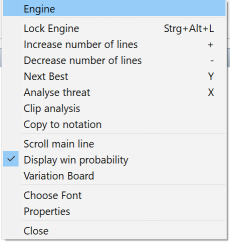
One of the characteristics of the neural networks is that they learn and evaluate a position based on winning chances. Fat Fritz will break this down into not only the overall winning chances, but the expected wins, draws and losses. This is useful since saying a position has a 50% chance won't tell you if that means it expects 50% wins and 50% losses, or just 100% draws. Fritz 17 has been modified to allow users to see this pure output of the neural network.

There is a new engine output option “Display win probabilities” that is active by default. When you run the engine you will also see the breakdown at the bottom. You can see the first is the overall win rate, followed by the details of the wins, draws and losses.
Learn Chess Opening with Fritz 17
In Fritz 17 you will find several new opening management and training functions:
Manage your openings with "My Moves"
The new opening repertoire in Fritz 17 is called "My Moves". It is separate for White and Black. You add variations to your repertoire by clicking on a move anywhere in the program and marking it as "My Move". This will include the whole variation up to this move into your repertoire. Marking moves is the only way to store variations, but this also saves a lot of time from entering moves one by one, copying from a source.
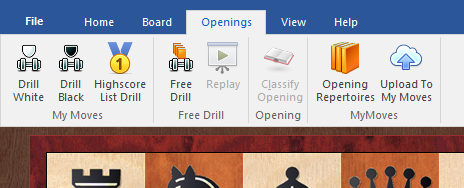
Your "My Moves" repertoire is stored online. You can access it from any machine, and also from a web browser. But the goodies don't stop there. Imagine you are watching a live game in Playchess, whether a casual blitz, or a broadcast from a top GM tournament. Even then you can instantly check to see if a game played is following an opening from your repertoire.
In the LiveBook in Fritz (and via the web app as in the image below) the moves will be color coded, and you can see if the move is in your repertoire already. If it isn't, just click on it to add it.
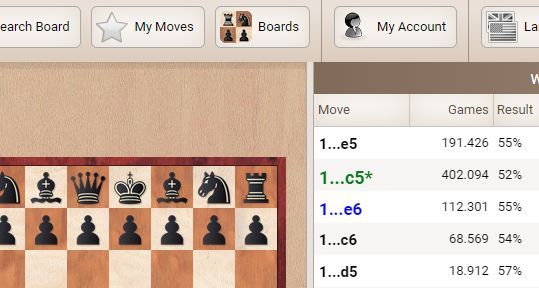
Blue = This move is in your repertoire for White.
Green = Move is in your repertoire for Black.
Cyan = You play this move with both colors.
* (an asterisk) = Marked as 'My Move'.
** (to asterisks) = Marked as 'Important for me'.
Memorizing Opening Variations
Chess database software creates a seductive illusion. The well structured management of opening variations in your personal analysis creates the impression that one can reproduce them easily over the board. Of course pure opening research is fun. However for practical success you really have to be able to recall everything from memory. Fritz 17 introduces the Drill as an efficient and entertaining way to help with this.
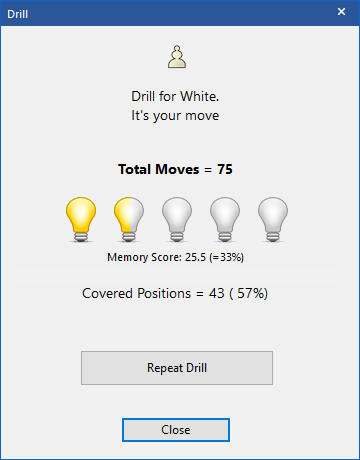
When Drilling, you play your lines and Fritz answers in a way that you stay within your prepared repertoires. Moves are played according to their frequency in master games.
After some time, Fritz 17 detects which variations you know well and which you don’t. Then the shakier systems are offered more frequently so that you can solidify your memory in an efficient way.
The drill dialog displays your ‘Memory Score’ If you reproduce the correct move for a position five times in a row, this position is counted as fully learned and scores one point. You have learned your repertoire 100% if you achieve this for any position.
Standard Repertoires
Fritz 17 provides access to standard opening repertoires for nearly every prominent line in chess. Those repertoires are regularly updated to current theory and recent games on our server. You can either drill them with Free Drill or upload them to ‘My Moves’. Or you pick single lines by marking moves. Of course you may simply store them in your traditional databases. Open a list by calling Openings → Standard Repertoires. Click on any entry and it will automatically load.
Standard Repertoires are available in four levels: Easy – Club – Tournament and Professional. This saves work: As a normal club player you don’t have to extract the best moves from a deeply nested professional repertoire suitable only for master level players.
Opening Theory 'Laid Back'
The best way to memorize opening variations is to execute moves physically. On the screen or even better on a board. Your brain will be more engaged in what you do. However, sometimes at the end of a long day you just might want to lean back, relax and leave mouse and keyboard untouched.
To satisfy this, Fritz 17 introduces the replay of variation trees. You can watch your repertoire being played out on the screen. Lines are picked randomly and repeated as often as you like. Just let it run, set the speed and watch.

Blitz & Train on Playchess.com
Still, learning is not just memorization, and improving upon one's games is a key part of it all. Here too new functions will now go through your games, or games of your choice, to highlight mistakes, combinations, or sacrifices, and present them as ready-made exercises you can solve on your computer, or print out for yourself or your students.
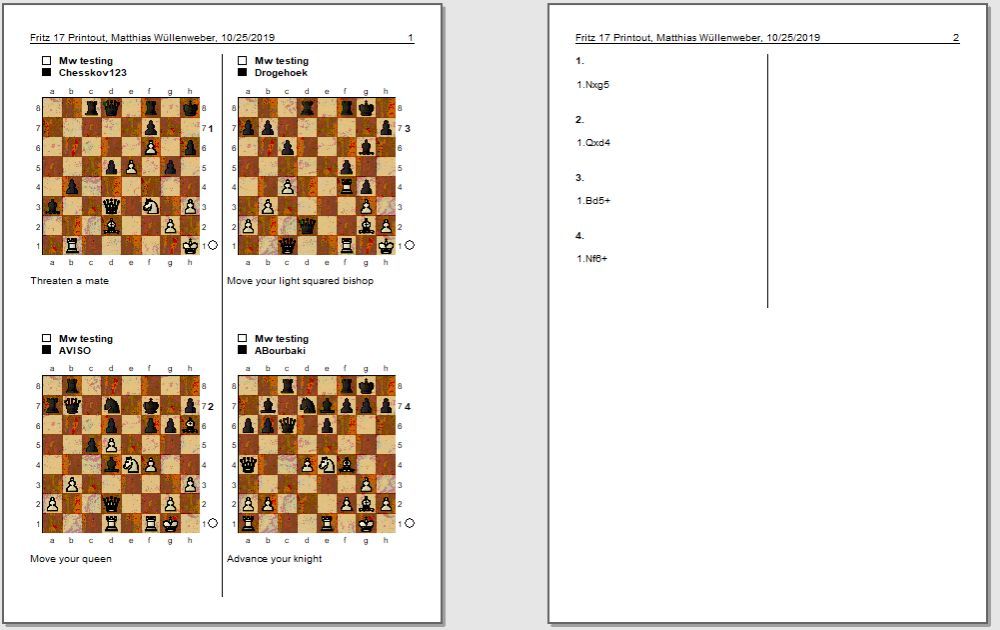
Blitz games contain tactical errors. Errors usually happen at interesting positions, so you can learn from them. Since the last version of Fritz, games played on Playchess.com are analysed automatically, but that brought a dilemma:
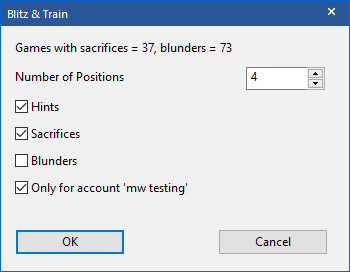
Should one look at the analysis or play the next game?
The new function “Blitz & Train” helps with this: It creates training material from your online games, no matter whether they have been played today or last month. A few clicks and you can print exercise sheets from your own games. Click the tab 'Training' in the Playchess section of Fritz:
The option Sacrifices finds exercises with beautiful moves, while Blunders asks for the best move in position where one side blundered.
3D boards with Ray Tracing
With the arrival of the newest generation of video cards from Nvidia, Ray Tracing has now become a reality in real time. In a nutshell the idea is that it is able to calculate and show light reflections from surface to surface in all of the incredibly complex relationships such as sunlight bouncing off a wall, which gives a lighter light, filtered through humid air, and so on. ChessBase has now introduced this added layer of realism to its 3D boards, with full control over every aspect if such is your desire.

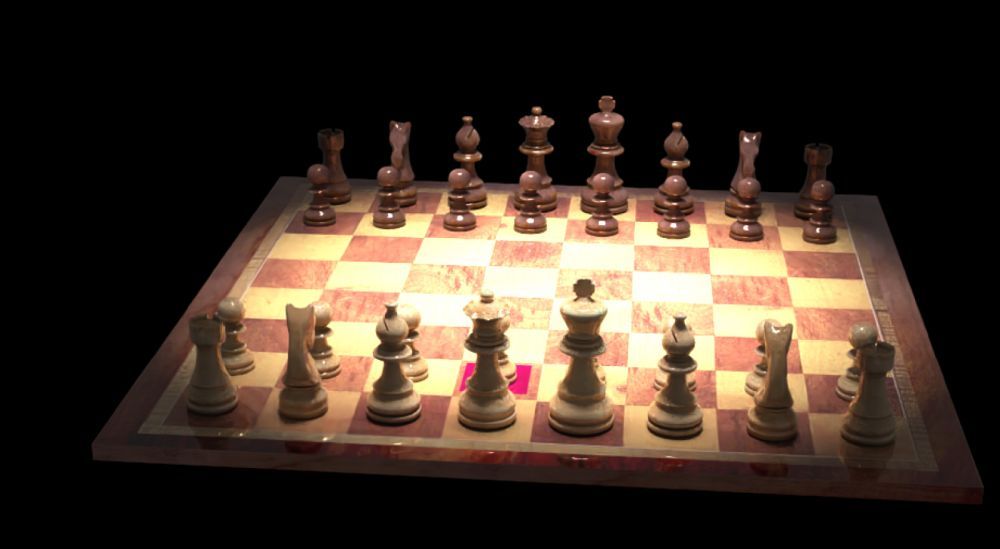
The options are enormous and even include fancy optical effects such as background blurring.
The options are enormous and even include fancy optical effects such as background blurring.
We hope you enjoy Fritz 17 !
Fritz 17 represents one of the most ambitious and progressive versions ever, bringing to you tools that should help all players contend with modern problems. From the challenges of memorizing and studying complex opening theory, to easily reviewing games with a focus on improving your practical skills, to bringing what is bound to be an amazing addition to your arsenal of tools: Fat Fritz. In fact, Fritz 17 brings not one engine, but four: a brand new Fritz 17 engine, the new custom made neural network Fat Fritz with its penchant towards cutthroat chess, the well-established Leela with its very Karpovian approach to chess in a no-headache installation, and Stockfish itself. Plus a surprise in the near future!

Order Fritz 17 at our shop
Buy ChessBase 15 and Fritz 17 together











